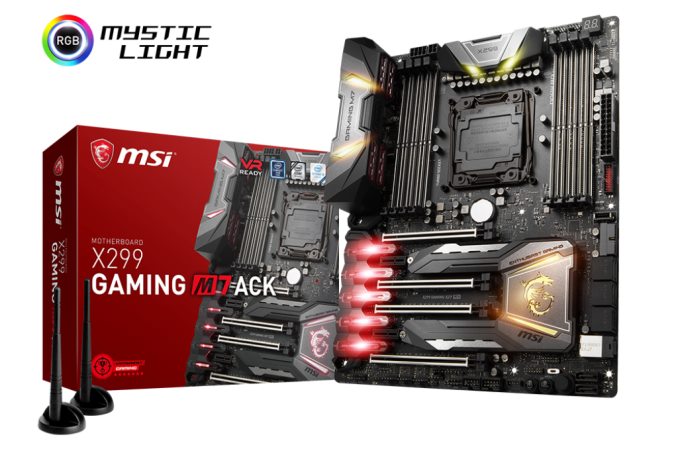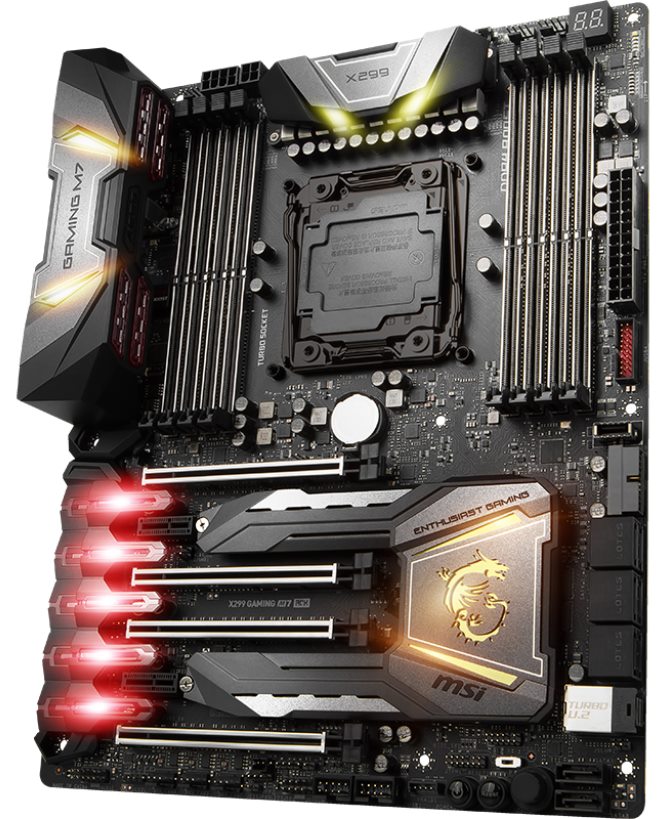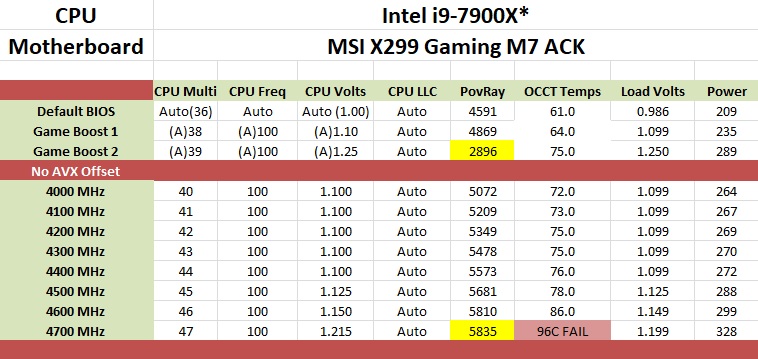The MSI X299 Gaming M7 ACK Motherboard Review: Light up the Night
by Joe Shields on March 5, 2018 10:00 AM EST- Posted in
- Motherboards
- MSI
- ATX
- M.2
- USB 3.1
- RGB
- X299
- Basin Falls
- Skylake-X
- Kaby Lake-X
- i9-7900X

What happens when a vendor adds 802.11ac to Killer networking? You get an ACK - specifically, the MSI X299 Gaming M7 ACK. This motherboard includes 3-way SLI and Crossfire support, dual M.2 slots with a unique heatsink design attached to the chipset, both front and rear USB 3.1 (10 Gbps) ports, dual Realtek audio chips, Killer based networking, and plenty of RGB LEDs to light up the case.
MSI X299 Gaming M7 ACK Overview
With the X299 platform, users tend to drop into one of two categories: the all or the nothing. A user investing in X299 is either trying to get everything, every feature, with multiple graphics cards and displays and lots of memory, or they are trying to get the high-end on the cheap. I remember the days when investing in X58 to get a Core i7-920 and overclocking it was seen as the height of aiming at performance, compared to investing in a Core i7-800 series platform. Back then, X58 was a stepping stone into HEDT. But here, the MSI X299 Gaming M7 ACK, or M7 ACK for short, is clearly aimed at users who want it all: more cores, more memory, more graphics cards, more storage, more network connectivity, and most importantly, more LEDs. If you wanted to light up the night, this is one motherboard that can certainly do that for you.
Buy MSI X299 Gaming M7 ACK on Amazon.com
Aside from features and LEDs, there is one consistent metric in all motherboard reviews. Our performance results placed the M7 ACK right in the middle of the pack, performing well overall. The form of Multi-Core Enhancement it has runs the benchmarks in the 3.6 GHz range, as do the majority of other motherboards tested. The main system performance win was the fact that it was the fastest MSI board to boot that we have tested so far. But users investing in this system should look into the overclocking.
Manually overclocking our Core i9-7900X was met with little fanfare, as this board happily took our i9-7900X CPU to 4.6 GHz before running into our temperature limit. Using the automated OC tool, Game Boost, was a different story. We were only able to reach the 2nd boost level before the CPU was throttling due to the voltage causing temperatures to be too high for the settings. Through it all, the smaller heatsink covering the VRMs did a good job keeping temperatures to an acceptable level during our extended stress testing peaking at 75C while overclocked to 4.5 GHz.
The M7 ACK allows users to have all the options for storage connectivity. There are eight SATA ports along with two M.2 slots. These slots are both covered by the unique hinged heatsink attached to the chipset heatsink. Both M.2 slots support PCIe and SATA modules, and share bandwidth with the U.2 port and SATA ports.
The board comes with four full-length PCIe slots in positions 1, 3, 4, and 6. Those slots are all connected through the CPU and intended for video cards. PCIe slots 2 and 5, both PCIe 3.0 x1, are connected through the chipset. For connectivity, there is a total of four USB 3.0 ports (three managed by ASMedia 1074, one by the chipset), three USB 2.0 ports (chipset), and two USB 3.1 ports (Type-A and Type-C, ASMedia 3142) on the back panel. Internally there are additional headers for both USB 3.0/USB3.1 as well as two USB 2.0 headers.
For networking, MSI chose to go with an all Killer-solution here. The board uses Rivet Networks latest Killer E2500 NIC for wired duty and the Killer Wireless-AC 1535 module for wireless, which comes pre-installed in the M2 (Key E) slot. The 802.11ac module supports Bluetooth 4.1 and speeds up to 867 Mbps. The networking is built into the name of the motherboard - Killer networking and 802.11ac gives 'AC' and 'K', for ACK.
Pricing for the MSI X299 Gaming M7 ACK is $390 at Newegg and $365 (from $420) at Amazon. This price point puts it in some decent company in the the $350-$400 range including the ASRock Fatal1ty X299 Professional Gaming i9 currently listed at $390 (from $399), the ASUS ROG Strix X299-XE Gaming at $370, and the GIGABYTE X299 AORUS Ultra Gaming Pro priced at $350. If U.2 is needed, the MSI board is the hands down choice, otherwise, users will need to filter through faetures they need and want as well as consider looks and price.
MSI X299 Strategy
MSI brings a current total of eleven X299 boards to choose from: the MSI X299 XPower Gaming AC holds the flagship title and makes its home in the Enthusiast Gaming segment along with the X299 Gaming M7 ACK. There are a total of three boards in the Performance Gaming hierarchy in the X299 Gaming Pro Carbon AC, Gaming Pro Carbon, and X299M Gaming Pro Carbon AC (mATX). The Arsenal line carries the three Tomahawk boards, the X299 Tomahawk, the X299 Tomahawk Arctic and the X299 Tomahawk AC, while the Pro lineup for professionals has three motherboards; X299 SLI Plus, X299 Raider, and X299M-A Pro.
| MSI's X299 Motherboard Lineup (1/29) | |||
| AnandTech Review |
Amazon | Newegg | |
| X299 XPower Gaming AC | [review planned] | $450 | $450 |
| X299 Gaming M7 ACK | [this review] | $366 | $380 |
| X299 Gaming Pro Carbon AC | Review 9/21 | $273^ | $330 |
| X299 Gaming Pro Carbon | $320 | $320 | |
| X299M Gaming Pro Carbon AC | [in editing] | $277 | $290 |
| X299 Tomahawk AC | $273 | $290 | |
| X299 Tomahawk Arctic | Review 11/20 | $280 | $280 |
| X299 Tomahawk | $256 | $270 | |
| X299 SLI PLUS | Review 11/29 | $232 | $220 |
| X299 Raider | $215 | $220 | |
| X299M-A Pro | - | $237^ | |
^ Third Party Sellers
Information on Intel's X299 and our other Reviews
With Intel's release of the Basin Falls platform, encompassing the new X299 chipset and LGA2066 socket, a new generation of CPUs called Skylake-X and Kaby Lake-X were also released. The Skylake-X CPUs range from the 7800X, a hex-core part, all the way up to an 18-core 7980XE multitasking behemoth. Between the bookend CPUs are five others increasing in core count, as in the table below. The latter HCC models are set to be launched over 2H of 2017.
| Skylake-X Processors | ||||||||
| 7800X | 7820X | 7900X | 7920X | 7940X | 7960X | 7980XE | ||
| Silicon | LCC | HCC | ||||||
| Cores / Threads | 6/12 | 8/16 | 10/20 | 12/24 | 14/28 | 16/32 | 18/36 | |
| Base Clock / GHz | 3.5 | 3.6 | 3.3 | 2.9 | 3.1 | 2.8 | 2.6 | |
| Turbo Clock / GHz | 4.0 | 4.3 | 4.3 | 4.3 | 4.3 | 4.3 | 4.2 | |
| Turbo Max Clock | N/A | 4.5 | 4.5 | 4.4 | 4.4 | 4.4 | 4.4 | |
| L3 | 1.375 MB/core | 1.375 MB/core | ||||||
| PCIe Lanes | 28 | 44 | 44 | |||||
| Memory Channels | 4 | 4 | ||||||
| Memory Freq DDR4 | 2400 | 2666 | 2666 | |||||
| TDP | 140W | 140W | 165W | |||||
| Price | $389 | $599 | $999 | $1199 | $1399 | $1699 | $1999 | |
Board partners have launched dozens of motherboards on this platform already, several of which we will have an opportunity to look over in the coming weeks and months.
Other AnandTech X299 Motherboard Reviews:
- The Intel Skylake-X Review: Core i9-7980XE and Core i9-7960X Tested
- The Intel Skylake-X Review: Core i9-7900X, i7-7820X and i7-7800X Tested
- The Intel Kaby Lake-X Review: Core i7-7740X and i5-7640X Tested
- Intel Announces Basin Falls: The New High-End Desktop Platform and X299 Chipset
- ($480) The ASUS Prime X299-Deluxe Review [link]
- ($400) The GIGABYTE X299 Gaming 7 Pro Review [link]
- ($390) The ASRock X299E-ITX/ac Review [link]
- ($390) The ASRock X299 Professional Gaming i9 Review [link]
- ($370) The ASUS Strix X299-XE Gaming Review [link]
- ($366) The MSI X299 Gaming M7 ACK Review (this review)
- ($308) The MSI X299 Gaming Pro Carbon Review [link]
- ($340) The ASUS X299 TUF Mark 1 Review [link]
- ($330) The EVGA X299 FTW-K Review [link]
- ($290) The EVGA X299 Micro Review [link]
- ($290) The ASRock X299 Taichi Review [link]
- ($260) The MSI X299 Tomahawk Arctic Review [link]
- ($232) The MSI X299 SLI Plus Review [link]
To read specifically about the X299 chip/platform and the specifications therein, our deep dive into what it is can be found at this link.
X299 Motherboard Review Notice
If you’ve been following the minutiae of the saga of X299 motherboards, you might have heard some issues regarding power delivery, overclocking, and the ability to cool these processors down given the power consumption. In a nutshell, it comes down to this:
- Skylake-X consumes a lot of power at peak (150W+),
- The thermal interface inside the CPU doesn’t do much requiring a powerful CPU cooler,
- Some motherboard vendors apply Multi-Core Turbo which raises the power consumption and voltage, exacerbating the issue
- The VRMs have to deal with more power, and due to losses, raise in temperature
- Some motherboards do not have sufficient VRM cooling without an active cooler
- This causes the CPU to declock or hit thermal power states as to not degrade components
- This causes a performance drop, and overclocked systems are affected even more than usual
There has been some excellent work done by Igor Wallossek over at Tom’s Hardware, with thermal probes, thermal cameras, and performance analysis. The bottom line is that motherboard vendors need to be careful when it comes to default settings (if MCT is enabled by default) and provide sufficient VRM cooling in all scenarios – either larger and heavier heatsinks or moving back to active cooling.













32 Comments
View All Comments
Diji1 - Wednesday, March 7, 2018 - link
>don't buy that QoS bullshit, Ian, you're not stupid, if some idiot is shittorenting on ADSL no amount of qosSo you've never used (or properly configured?) a device with QoS then I take it because if you had you wouldn't be dribbling inane stuff from your imagination like this.
karakarga - Wednesday, March 7, 2018 - link
New mainboards may start to use Doby Atmos playback with 9.1.6 output. New UHD films may soon adapt to it. Buying an amplifier is really expensive for hearing it. Computer with the help of CPU may ease it for us.PeachNCream - Monday, March 5, 2018 - link
Lots of us have a very good understanding of networking so don't discount us as lacking the knowledge necessary to make sense of what Rivet Networks says their hardware is doing with respect to packet analysis and traffic prioritization. Maybe the specific implementation is unique to Killer NICs (I'd even argue that's not the case since they're moving to Intel hardware so if there is packet prioritization happening in hardware, it'll eventually be Intel's implementation with Rivet's interface atop it to allow user configuration). It also seems preconceived (alarmingly so) to assume the readers would just pop in to make negative comments if you go through the trouble of running benchmarks. I'd like to think there's value in what Anandtech publishes which is why most of us, even those with strongly negative opinions about Killer products, are here in the first place reading articles. Some of us don't clearly articulate why we don't like something though. Instead it might come off as general loathing, but I think the feedback you're getting here is rooted in the favorable light Killer is cast in without supporting data that's further combined with negative customer experiences of past Killer NIC products. If you'd like to address that perception and remain as outwardly positive quantified data that isn't marketing material direct from the company would go a long way because claims would have the necessary backing.I do worry though, that the Killer NIC's benefits can't be realized in benchmarks. If its the case that the key selling points aren't measurable, repeatable, or demonstrable then do they really exist? Are the use cases where a Killer NIC's benefits most likely to be realized commonplace enough to begin with and if they are, what sorts of difficulties make measurement so elusive? It's hard to accept the sales pitch if there's not a trustworthy third party out there that can show they actually exist.
I understand why you'd like to consult with Rivet's personnel in the process of finding a way to measure and demonstrate what their hardware can do, but surely they already went through this trouble to get the numbers for their marketing materials that would put their product performance into bar graphs alongside other common network adapters. They've got to have invented that wheel already if they're claiming those benefits since false claims would expose the company to legal liability. It'd be odd that they're mum about it since their hardware appeals to a crowd of technically-inclined consumers that get very excited over a 2ms improvement in ping times to a game server.
nevcairiel - Tuesday, March 6, 2018 - link
>If you are gaming, plus downloading, plus streaming, plus watching youtube on another monitor etc,> the priority thing does its job.
I have my router doing proper QoS, I can download at full speed and not notice a dip in gaming. IMHO the "bottleneck" in the network needs to perform this task for good results, and thats often the gateway from ethernet to the internet.
Lolimaster - Tuesday, March 6, 2018 - link
Downloading barely affects gaming sessions (game data downloaded from an online match is small), uploading beyond a certain threshold will kill it (climbing ms+).andychow - Monday, March 5, 2018 - link
I like the presence of U.2, but killer networking + RGB LEDS = no way I'm buying that. The RGB LEDs you can probably turn off, which just wastes a little money. But killer networking is really the deal breaker. It's something most people would pay extra to not have. Why do board makers ever accept using this brand?Even when killer hardware is based on Intel (these aren't), their custom firmware and drivers is just junk.
Look online, most people that have the Killer 1535 just end up getting another wifi card.
Gothmoth - Monday, March 5, 2018 - link
no word about the bios issues... anandtech articles are now basically just a feature list with more words.Joe Shields - Wednesday, March 7, 2018 - link
What BIOS issues? I did not run into any throughout testing. Perhaps the BIOS used fixed something from previous versions? Do you have a link to said problems?timecop1818 - Monday, March 5, 2018 - link
> What happens when a vendor adds 802.11ac to Killer networking?You lose sales.
Fuck killer and fuck any vendor that uses their shit.
jjj - Monday, March 5, 2018 - link
1 year later, AT still avoids Ryzen mobos with extreme ferocity.And it gets so much worse worse, you focus on X299, a platform almost nobody buys.
Go count the mobo reviews in the last year. By my count , you got;
12 reviews for X299
6 reviews for for Z270
2 reviews for for Z370
2 reviews for X370
1 review for TR
Objectivity and serving the reader might not be this site's goal but even if your goal is to sell hardware, how is focusing on products that do not sell, serving your financial interests.
The way this makes sense, is if someone is paying you to promote x299 at any cost. Otherwise, what you are doing is insanity.